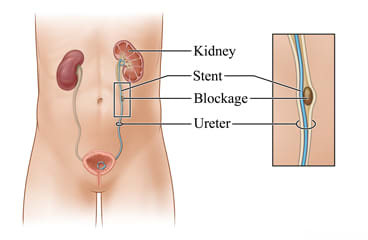Your Recovery

A ureteral (say "you-REE-ter-ul") stent is a thin, hollow tube that was placed in your ureter to help urine pass from the kidney into the bladder. Ureters are the tubes that connect the kidneys to the bladder.
There are several ways to remove the stent. The stent may have been removed by your doctor in a hospital or your doctor's office. Or it may have been taken out at home.
After the stent removal, you may need to urinate often. You may have some burning during and after urination for a day or two. It may help to drink lots of fluids (unless your doctor tells you not to). This also helps prevent a urinary tract infection.
Slightly pink urine is common for several days after removal.
This care sheet gives you a general idea about how long it will take for you to recover. But each person recovers at a different pace. Follow the steps below to get better as quickly as possible.
How can you care for yourself at home?
Activity
- Rest when you feel tired.
- Allow your body to heal. Don't move quickly or lift anything heavy until you are feeling better.
- Most people are able to return to work the day after the procedure. If your work requires intense activity, you may feel pain in your kidney area or get tired easily. If this happens, you may need to do less strenuous activities while you heal.
Diet
- You can eat your normal diet. If your stomach is upset, try bland, low-fat foods like plain rice, broiled chicken, toast, and yogurt.
- Drink plenty of fluids (unless your doctor tells you not to).
Medicines
- Your doctor will tell you if and when you can restart your medicines. You will also get instructions about taking any new medicines.
- If you take aspirin or some other blood thinner, ask your doctor if and when to start taking it again. Make sure that you understand exactly what your doctor wants you to do.
- Be safe with medicines. Read and follow all instructions on the label.
- If you are not taking a prescription pain medicine, ask your doctor if you can take an over-the-counter medicine.
- If the doctor gave you a prescription medicine for pain, take it as prescribed.
- Store your prescription pain medicines where no one else can get to them. When you are done using them, dispose of them quickly and safely. Your local pharmacy or hospital may have a drop-off site.
- If your doctor prescribed antibiotics, take them as directed. Do not stop taking them just because you feel better. You need to take the full course of antibiotics.
Follow-up care is a key part of your treatment and safety. Be sure to make and go to all appointments, and contact your doctor if you are having problems. It's also a good idea to know your test results and keep a list of the medicines you take.
When should you call for help?
Call 911 anytime you think you may need emergency care. For example, call if:
- You passed out (lost consciousness).
- You have chest pain, are short of breath, or cough up blood.
Contact your doctor now or seek immediate medical care if:
- You have pain that does not get better after you take pain medicine.
- You have new or more blood clots in your urine. (It is normal for the urine to be pink for a few days.)
- You are unable to urinate.
- You have symptoms of a urinary tract infection. These may include:
- Pain or burning when you urinate.
- A frequent need to urinate without being able to pass much urine.
- Pain in the flank, which is just below the rib cage and above the waist on either side of the back.
- Blood in your urine.
- A fever.
- You are sick to your stomach or cannot drink fluids.
- You have symptoms of a blood clot in your leg (called a deep vein thrombosis), such as:
- Pain in the calf, back of the knee, thigh, or groin.
- Swelling in your leg or groin.
- A color change on the leg or groin. The skin may be reddish or purplish.
Watch closely for any changes in your health, and be sure to contact your doctor if you have any problems.
Current as of: April 9, 2025
Author: Ignite Healthwise, LLC Staff
Clinical Review Board
All Ignite Healthwise, LLC education is reviewed by a team that includes physicians, nurses, advanced practitioners, registered dieticians, and other healthcare professionals.

